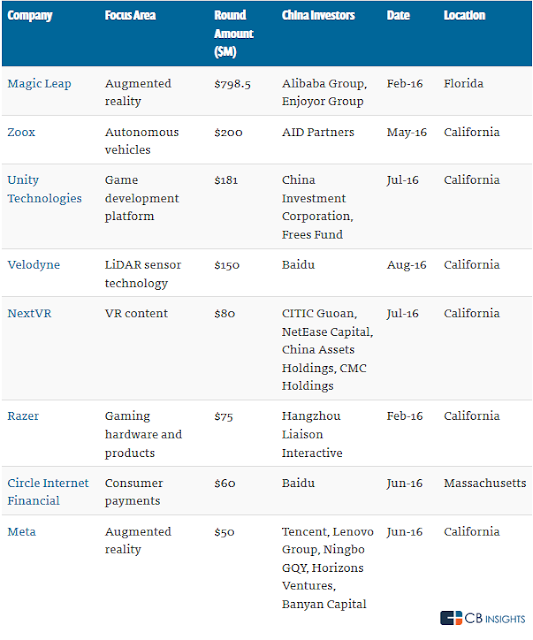China starting to acquire some technology companies
by noreply@blogger.com (brian wang) from NextBigFuture.com on (#2HDAJ)
China's outbound Merger and Acquisition activity surged in 2015 and 2016 with a broad universe of acquirers executing transactions with an increase in pace and deal size.
This surge has been driven by a range of macro factors, including the pursuit of long-term and sustainable growth, consumption by the rising middle class, and a favorable regulatory and financing environment. Chinese buyers are becoming more active and experienced in M and A and are comfortable executing public takeovers and arranging acquisition financing in overseas markets.
Global mergers and acquisitions set a record in 2015 with transaction volume reaching nearly $5 trillion, driven by the globalization of the M&A market and the emergence of Asia Pacific as a key player in it. Asia Pacific companies' appetite for M and A has increased due to a range of macro factors, with overall Asia Pacific M and A volume approximately doubling from $748 billion in 2013 to $1.5 trillion in 2015.
Chinese buyers are playing an increasing role in Asia Pacific M and A activity, with their volume nearly tripling from $259 billion in 2013 to $735 billion in 2015. In addition, seven of the 10 largest cross-regional acquisitions out of Asia Pacific in the first four months of 2016 were announced by Chinese buyers.
China is transforming its economy from export-driven manufacturing to one driven by technology, industrial know-how and consumption. The strategic priorities of Chinese buyers have evolved to reflect this shift. Chinese companies are acquiring North American and European companies to enhance technological capabilities and move the nation's industrial sector upstream, to obtain high-value brands that can be offered to the maturing consumer in China, and to build scale and distribution in strategically important markets and geographies. Chinese companies are looking beyond market share in China to global markets, with their sights set on becoming market leaders globally.
China invested $9.9 billion into new Silicon Valley firms in 2015 and made an additional $3.5 billion in tech investments in the first nine months of last year.
- Boston-based artificial intelligence start-up Neurala
- China bought US tech companies make rocket engines for spacecraft, sensors for autonomous navy ships, and printers that make flexible screens that could be used in fighter-plane cockpit
- In May 2015, Haiyin Capital invested an undisclosed in XCOR Aerospace, a Mojave, Calif., commercial space-travel company that makes spacecraft and engines and has worked with NASA
- In 2016, Tianjin Tianhai bought Ingram Micro for $6.07 Billion
- In 2015,WeEn Semiconductor acquired NXP Power Semiconductors for $1.8 billion. ISSI was acquired by a Chinese consortium for $765 million; and Hua Capital Management Co. Ltd. Acquired OmniVision Technologies for $1.9 billion.
- In 2016, a Silicon Valley start-up called Kateeva that makes machines that print flexible screens raised $88 million from a group of Chinese investors.




Read more










This surge has been driven by a range of macro factors, including the pursuit of long-term and sustainable growth, consumption by the rising middle class, and a favorable regulatory and financing environment. Chinese buyers are becoming more active and experienced in M and A and are comfortable executing public takeovers and arranging acquisition financing in overseas markets.
Global mergers and acquisitions set a record in 2015 with transaction volume reaching nearly $5 trillion, driven by the globalization of the M&A market and the emergence of Asia Pacific as a key player in it. Asia Pacific companies' appetite for M and A has increased due to a range of macro factors, with overall Asia Pacific M and A volume approximately doubling from $748 billion in 2013 to $1.5 trillion in 2015.
Chinese buyers are playing an increasing role in Asia Pacific M and A activity, with their volume nearly tripling from $259 billion in 2013 to $735 billion in 2015. In addition, seven of the 10 largest cross-regional acquisitions out of Asia Pacific in the first four months of 2016 were announced by Chinese buyers.
China is transforming its economy from export-driven manufacturing to one driven by technology, industrial know-how and consumption. The strategic priorities of Chinese buyers have evolved to reflect this shift. Chinese companies are acquiring North American and European companies to enhance technological capabilities and move the nation's industrial sector upstream, to obtain high-value brands that can be offered to the maturing consumer in China, and to build scale and distribution in strategically important markets and geographies. Chinese companies are looking beyond market share in China to global markets, with their sights set on becoming market leaders globally.
China invested $9.9 billion into new Silicon Valley firms in 2015 and made an additional $3.5 billion in tech investments in the first nine months of last year.
- Boston-based artificial intelligence start-up Neurala
- China bought US tech companies make rocket engines for spacecraft, sensors for autonomous navy ships, and printers that make flexible screens that could be used in fighter-plane cockpit
- In May 2015, Haiyin Capital invested an undisclosed in XCOR Aerospace, a Mojave, Calif., commercial space-travel company that makes spacecraft and engines and has worked with NASA
- In 2016, Tianjin Tianhai bought Ingram Micro for $6.07 Billion
- In 2015,WeEn Semiconductor acquired NXP Power Semiconductors for $1.8 billion. ISSI was acquired by a Chinese consortium for $765 million; and Hua Capital Management Co. Ltd. Acquired OmniVision Technologies for $1.9 billion.
- In 2016, a Silicon Valley start-up called Kateeva that makes machines that print flexible screens raised $88 million from a group of Chinese investors.




Read more